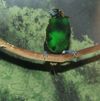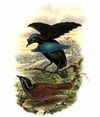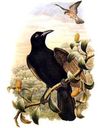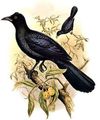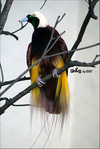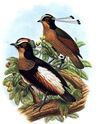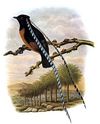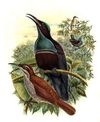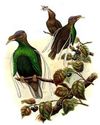Family Paradisaeidae
Astrapia - They are endemic to New Guinea.
Cicinnurus - All three species are sexually dimorphic and have bright blue legs and feet.
Epimachus - The genus Epimachus consist of four species birds of paradise with long decurved sickle-like bill.
Lophorina - The Superb Bird-of-paradise is distributed throughout rainforests of New Guinea.
Lycocorax - One of the few monogamous birds of paradise, the Paradise-crow is endemic to lowland forests of the Maluku islands in Indonesia.
Manucodia - Distributed in the lowland forests of northeastern Australia, New Guinea and nearby islands, members of this genus are monogamous and sexually monomorphic.
Paradigalla - The genus Paradigalla Lesson, 1835 consist of two species of birds of paradise.
Paradisaea - All are large, and sexually dimorphic.
Parotia - The males of the genus are characterized by an ornamental plumage consisting of six-wired head plumes with black oval-shaped tips, a neck collar of black, decomposed feathers which can be spread into a skirt-like shape, and bright or iridescent head and throat markings.
Pteridophora - Both the common name "King of Saxony" and the scientific specific name "alberti" were given to honour Albert of Saxony.
Ptiloris - It is distributed in the rainforests of New Guinea and Australia.
Seleucidis - The sole representative of the monotypic genus Seleucidis, the Twelve-wired Bird-of-paradise is a bird of lowland forests.
Semioptera - George Robert Gray of the British Museum named this species in honor of Alfred Russel Wallace, British naturalist and author of The Malay Archipelago, who discovered the bird in 1858.


